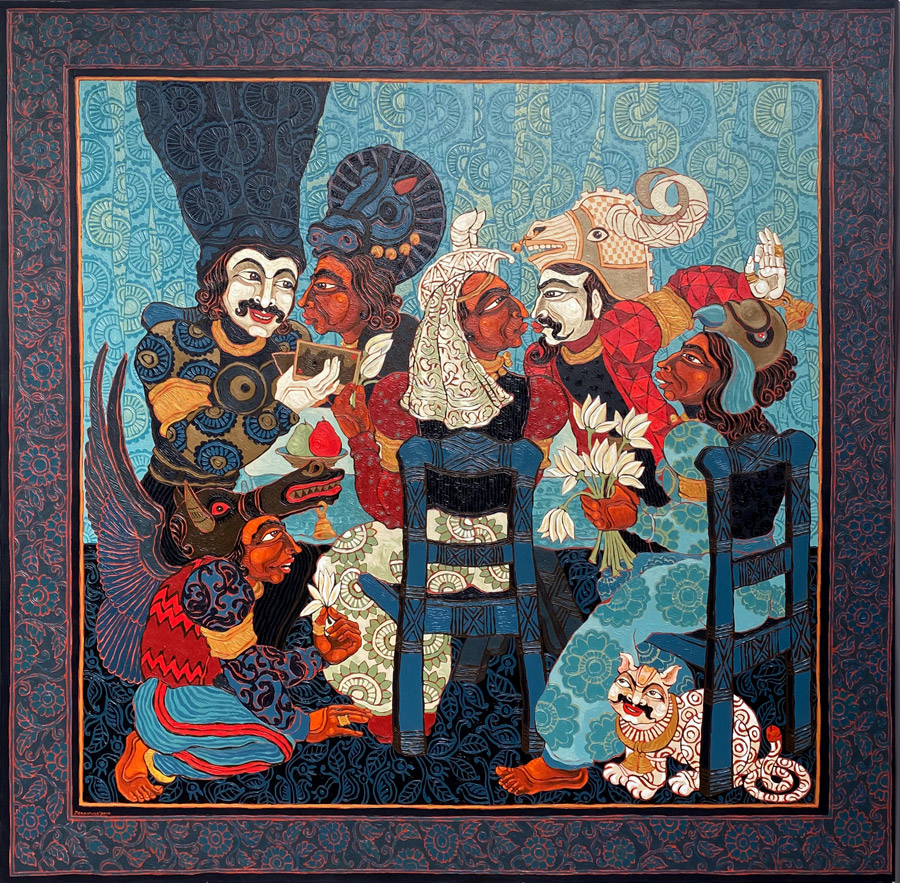
By Aaruna Bhowmick - 30 Nov, 2019
Chronicle of Humanism
Pradiptaa Chakraborty’s work tells many stories, it is a re-invention of lore, legion and sagas
Pradiptaa Chakraborty is a Viswabharati, Shantiniketan-trained artist currently showing at the Dhoomimal Arts Centre, New Delhi. Vibrantly colourful, rich and complex in tone and texture one would do well to enter the show at leisure, time in hand, for thereafter, in all likelihood, it will remain leisure no longer.
Every work has a story to tell, each the artist's re-invention of lore, legion and sagas retold. Forms and figures dance a jig in visual communion, even as richly worked drapery and fabric design complement the narrative, encasing the protagonists within their fine and rich lustre. Though the compositions themselves remain unconventional, he tends to cast them within the frame of traditional Indian miniatures, with pure flat colours, elaborate fabric, and linear bindings.
His references are manifold, both in style and content, and in certain terms of visual vocabulary his textbooks many, making it a veritable synopsis of various narratives and art practices of some of his seniors, and fellow contemporaries. Commendable for his thorough study and dedicated application, his amalgam of adaptations emerged thereafter as thoroughly renewed and by now entirely his own. Subjects chosen by Chakraborty vary from real-life characters such as Natee Binodini, the 19th-century prostitute who rose to become a pioneering Bengali stage actress and the first in her line to pen down an autobiography. Instead of trying to create a coherent historical narrative complete in its experienced details, it seems characteristic of Pradiptaa to present a deliberately fragmented, if somewhat subverted visual narrative, ruptured, silent and mysterious. Thus Binodini, in conjunction with Mahabharata's Draupadi, are both protagonists in the artist's narrative of unjustly treated women.
Manet’s Olympia, is transformed into Chameli, with a dark manservant replacing the black slave featured in Manet's painting. In "Gustav Believed... La Fiesta in Oscula” the couple embraced in a kiss are vastly removed from Klimt's world-renowned work. The Kiss.
Then again in the work derived from the famed The Last Supper, as the central figure Christ is replaced by a mustachioed chef who has been referred to as "Maa", the mother- the hand that feeds. Delving into gender issues for the most part transgender love relationships do not truffle the artist, for to his mind genuine affection should not be governed by boundaries of colour, race, region or gender. A boundless, universal love, would to the artist be the ideal world, a catharsis for all of humankind, fair and seamless in purity.
Living in a world fraught with constant judgements, assessments, criticisms, ever struggling to fit in- be it at work, home or a social gathering, depression, low self-esteem, sadness and insecurity have come to characterise our society: Hollow and shallow, is our only tie with our fellow human beings to be the DNA? When is to come
a time to wake up from this nightmare?
Thus it is that Pradiptaa's Chronicle of Humanism maintains, "Every form represents a chariot; consciousness is the charioteer, intuition its harness, and the five senses are the five horses. Conquering one's wandering consciousness is the essence of human life."

